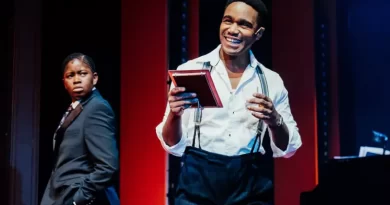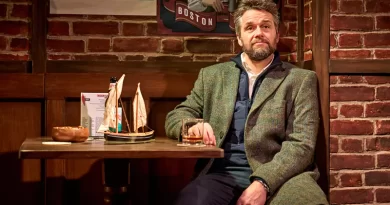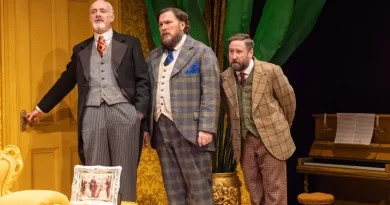“Wedding Band” at Lyric Hammersmith
Simon Jenner in west London
7 June 2024
“It’s wrong to hate, they say. It’s wrong to love, too,” the young Black woman Julia at the heart of this play declares. Alice Childress’s 1962 Wedding Band directed by Monique Touko at the Lyric Hammersmith is set in 1918, but consciously addresses some of that period’s themes through a lens of Civil Rights. Indeed, after much anxiety the play was only finally staged in 1966. The army draft or volunteering felt different at a time of Vietnam. Here, there’s much made of the irony of Black patriotism. The emphasis though lies in the subtitle: “A Love/Hate Story in Black and White.”

David Walmsley as Herman.
Photo credit: Mark Senior.
That describes the two lovers to a point; but conflict arises more from the effect of white interlopers. Set in a Black South Carolina community, deep in the Jim Crow territories with its segregation laws – forbidding interracial marriage for instance – it revolves round the ten-year bi-racial relationship between Julia (Deborah Ayorinde, making her UK stage debut), who is a seamstress, and baker Herman (David Walmsley) from a German-heritage family.
That Herman’s sister Annabelle is a “concert pianist” because she once played in a hall tells you all you need to know of the family’s pretensions. In an America newly hostile to ethnic Germans, they are feeling the chill of (albeit very mild) racism too. Herman’s a distinct disappointment.
Ayorinde and Walmsley move round each other with both a sexual ease yet a flinch of anxiety, even shame of discovery. It’s why Julia always moves on and Herman is anxious for them to leave. He presents Julia with a wedding band, their names engraved.
Childress is particularly known in the UK for her great 1955 play about Black stereotyping in the film industry Trouble in Mind. It had two recent UK productions: the Coronet in 2017 and the National in 2021. Wedding Band is more unwieldy, even expressionist, but even more ambitious and hard-hitting. Touko, who directed School Girls; Or, The African Mean Girls Play at Lyric Hammersmith last year, allows Childress’s comedy to breathe, as well as racial tensions and tragedy.
The community emerges in Touko’s slow, almost processional roll-out of characters expressed in Paul Wills’s set, which is stark yet expansive. Moveable meshes create a whirl of fences that settle as tenements or interiors.

The ensemble.
Photo credit Mark Senior.
Matt Haskins’s lighting is often primary; there’s a striking sense of space and confinement, spareness and horizon. At the end, a suffused atmosphere drifts in from – seemingly – a different climate. Shiloh Coke’s music is at its most effective here, in Elena Peña’s sound which reaches to the back of the auditorium in tiny pockets.
Fences are bastions too, but fragile ones, as characters like travelling salesman Bell Man (Owen Whitelaw) attempt to accost Julia. In a performance that scorches to bleak affirmation at the end, Ayorinde is hardly off the stage, and has furthest to go. Her straightforward love for Herman, so different from other white men, has survived a decade. When her neighbours discover this, they are horrified.
Lachele Carl’s snobby landlady Fanny harps on responsibility, Belgian lace, and English porcelain. Wills’s costumes too show the slow sloughing-off of pre-war fashion as the flapper age slowly leaks in, ironically from white folks and, paradoxically, army uniforms. Fanny has a thing for Nelson (Patrick Martins), an upright young man joining the army, and yet just manages to hold off when Bell Man tells him to know his place, after being rebuffed by Julia. Nelson knows his place with her though.
Childress makes some fine class-differentiation between stuck-up Fanny and Nelson’s hard-up mother Lula (Diveen Henry), anxiously keeping him to the overly narrow, and warm Mattie (Bethan Mary-James), whose husband October is already in the Navy – and whose intimate letters, touchingly, Julia has to read to her. The desperation to appear respectable and law-abiding gives new force to Robert Frost’s “good fences make good neighbours” and the set, full of fences, acts like apartheid.
There remains a need to punch down though. Even warm-hearted Mattie can’t believe Julia brings such trouble inside. Yet Walmsley’s Herman, with simple desires for himself and Julia to leave for New York and a less-segregated world, seems straightforward enough. That’s till that other world comes knocking: the Spanish flu epidemic and Herman’s bustling family.
Ministering Annabelle (Poppy Gilbert) works at a flu hospital, but is mostly anxious for Herman to marry Celeste, so she can marry her Walter without opposition. Gilbert’s performance expresses a thaw in Annabelle only when confronted with her mother’s even greater racism and monstrosity.
Walmsley, who articulates Herman’s disdain for his family’s norms so resolutely, now conveys Herman’s love for Julia as something separate to her community, under pressure of illness and family. They slowly prise apart hidden seams of the son of a man indebted to the Klan.
Geraldine Alexander’s Thelma, arriving in a chilly bustle, finds a moment of rapprochement with anxious-to-impress Fanny. This influx of Herman’s family, however, sets up the first of Act Two’s enormous confrontations. The first involves the community, terraces a series of prejudices, mutual disgust, and rapidly bared hatred partly exacerbated by the new, anti-German prejudice.
After this the play’s arc stalls a little, moving to expressionism. Julia is persuaded to give a patriotic speech she doesn’t believe in to speed Nelson, leaving for the war. He rebuffs her insincerity. Dramatically this section shows Julia’s attitude towards white America shifting though it is overlong – the work lasts almost three hours (including interval). The effect though is electrifying: the same insincere speeches were being given in 1966.
There follows a return, a confrontation, and rapprochement, as well as reckoning. It makes for an emotional truth at the expense of a dramatic one. That hardly detracts from the enormous power and outrage of a work that connects so viscerally with the audience – particularly in the ferocity of Act Two.
The performers, particularly Ayorinde and Walmsley, are exemplary. And Ayorinde’s incandescent outrage most of all anneals character, content, and unashamed message. For that alone, the play is a must-see. There is, though, so much more to learn from Childress’s uncompromising vision, her refusal to conform to dramatic niceties.









